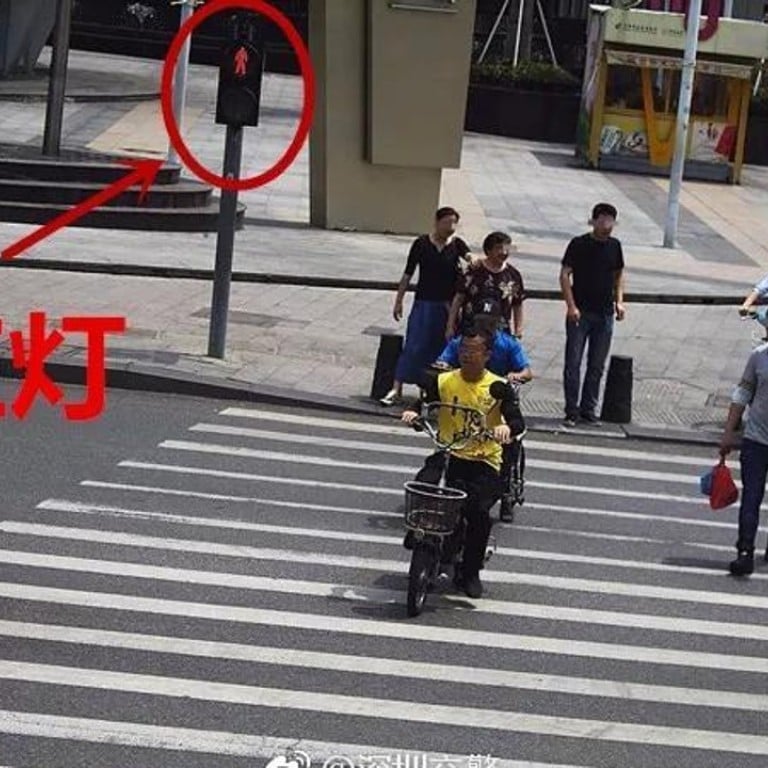
Shenzhen police can now identify drivers using facial recognition surveillance cameras
Expanded traffic surveillance programme in Shenzhen will identify and fine violators, including those driving without a valid license
The so-called electronic police system captures photos of vehicles that violate the traffic rules in the metropolis of 12 million people, providing an image of not only the number plate but also the driver’s face, which can then be identified from the police database using facial recognition technology. A total of 40 roads will be covered under the expanded surveillance, from the initial single intersection, to identify and fine traffic violators, including those driving without a valid license.
Drivers who had their licenses revoked due to illegal conduct such as driving under the influence of alcohol or drugs have already been captured and identified through the system, according to the Shenzhen Traffic Police’s official Sina Weibo account. The system, which went on trial Monday, will be officially launched on May 1.
The move is the latest in a push by Chinese cities and securities agencies to employ advanced artificial intelligence-based technologies in policing. Earlier this month a fugitive was arrested in southeast China after facial recognition technology helped identify him in a crowd of about 50,000 attending a pop concert. The country is also exporting such technology, with start-up Yitu Technology selling its body mounted cameras equipped with facial recognition software to the Malaysian police.
Shenzhen – home to major tech companies like Tencent, Huawei Technologies and ZTE, as well as thousands of well known start-ups such as DJI and BGI Genomics – has been a pioneer in adopting the most advanced technologies to deal with road rule violations.
Shenzhen traffic police first installed roadside speed cameras 1997 and in 2001 added surveillance systems to capture and identify car number plates.
Starting in April last year, the city began displaying photos of jaywalkers on large LED screens at major intersections, using facial recognition technology to identify them from a police database. As well as the photo, the offender’s family name and part of their government identification number are also shown on the LED screens located above the pavement.
Just jaywalked? Check your mobile phone for a message from police
“Cameras with 7 million pixels of resolution ensure that the image of drivers’ faces behind the [windscreen] are good enough for a facial comparison by our system, but only if the drivers’ facial information has been stored in the traffic police database can our system immediately recognise them,” Wang Jun, director of marketing solutions from Intellifusion, said in a phone interview.
The Shenzhen-based AI firm, which provides technology to the city’s traffic police, provided 20 ultra-HD cameras with 7 million pixel resolution and the same number of conventional 2 million pixel cameras. Ultra HD, or 4K surveillance cameras, can digitally zoom into a spot in the frame without losing resolution, leaving the days of grainy analogue CCTV footage far behind.
China’s AI dream is well on its way to becoming a reality
Wang said the traffic police take cost into consideration when decided which camera to adopt, with the ultra-HD cameras costing up to 400,000 yuan (US$63,400) each to equip at an intersection.
Surveillance cameras used mainly to capture images of moving cars require a higher pixel resolution whereas 2 million pixel cameras are sufficient to capture non-motor vehicles and pedestrians, he said. The 40 electronic police are mostly installed at intersections subject to high traffic flows, as well as in safety-conscious locations like schools.
Facial recognition technology becoming part of everyday life in China
As of 5pm Monday, a total of 169 traffic violators had been caught, according to Shenzhen Traffic Police’s Sina Weibo account. Most of the offenders were pedestrians and delivery people who did not follow traffic signals, as well as vehicles which used non-motorised lanes.
Traffic violators who are registered with the Shenzhen traffic police – a mandatory step for residents – receive a text message, which includes their name, identification card number, and details of the time and location of the offence.
For those who think they are safe from prying electronic eyes under cover of darkness, the new Shenzhen cameras come equipped with night-vision mode.

